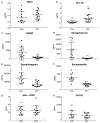Growth Hormone-Releasing Hormone Modulation of Neuronal Exosome Biomarkers in Mild Cognitive Impairment
- PMID: 30372675
- PMCID: PMC6487872
- DOI: 10.3233/JAD-180302
Growth Hormone-Releasing Hormone Modulation of Neuronal Exosome Biomarkers in Mild Cognitive Impairment
Abstract
Age-related changes in cognition are linked to decreased expression of somatotropins, GHRH and IGF-1. Mild cognitive impairment (MCI) and Alzheimer's disease (AD) are heterogeneous conditions. The loss of GHRH signaling in the brain may be mechanistically involved in AD pathogenesis. The consequent need to identify AD at an early and perhaps more treatable stage has fueled research into blood-based, exosome biomarkers. Plasma exosomes from participants enrolled in a randomized, double-blind, placebo-controlled 20-week trial of GHRH administration, were isolated, precipitated, and enriched by immuno-absorption with anti-L1CAM antibody (neural adhesion protein) from adults with MCI and age-matched, cognitively normal controls (CNC). Extracted protein cargo from neuronally-derived exosomes (NDEs) were assessed by ELISAs for protein levels implicated in AD neuropathology and for synaptic proteins altered by AD. Plasma NDE concentrations of Aβ1-42 were significantly increased while plasma NDE concentrations of NRGN, synaptophysin, synaptotagmin, and synaptopodin were significantly decreased in patients with MCI, independent of GHRH treatment. Plasma NDE concentrations of ptau-S396 and GAP43 were not affected by cognitive status (CNC versus MCI) or by GHRH treatment. Aβ1-42, neurogranin (NRGN), synaptophysin, synaptotagmin, and synaptopodin demonstrated the highest diagnostic accuracy for distinguishing between CNC and MCI patients, while synaptophysin and synaptotagmin demonstrated moderate accuracy in distinguishing between placebo-treated and GHRH-treated, MCI patients.
Keywords: Amyloid; GHRH; biomarker; growth hormone; mild cognitive impairment; neuronal exosomes; synapse; tau.
Figures



Similar articles
-
Prediction of conversion from mild cognitive impairment to dementia with neuronally derived blood exosome protein profile.Alzheimers Dement (Amst). 2016 May 7;3:63-72. doi: 10.1016/j.dadm.2016.04.001. eCollection 2016. Alzheimers Dement (Amst). 2016. PMID: 27408937 Free PMC article.
-
Increased prediction value of biomarker combinations for the conversion of mild cognitive impairment to Alzheimer's dementia.Transl Neurodegener. 2020 Aug 3;9(1):30. doi: 10.1186/s40035-020-00210-5. Transl Neurodegener. 2020. PMID: 32741361 Free PMC article.
-
Plasma neuronal exosomes serve as biomarkers of cognitive impairment in HIV infection and Alzheimer's disease.J Neurovirol. 2019 Oct;25(5):702-709. doi: 10.1007/s13365-018-0695-4. Epub 2019 Jan 4. J Neurovirol. 2019. PMID: 30610738 Free PMC article. Review.
-
Effects of growth hormone–releasing hormone on cognitive function in adults with mild cognitive impairment and healthy older adults: results of a controlled trial.Arch Neurol. 2012 Nov;69(11):1420-9. doi: 10.1001/archneurol.2012.1970. Arch Neurol. 2012. PMID: 22869065 Free PMC article. Clinical Trial.
-
Therapeutic Efficacy of Plasmalogens for Alzheimer's Disease, Mild Cognitive Impairment, and Parkinson's Disease in Conjunction with a New Hypothesis for the Etiology of Alzheimer's Disease.Adv Exp Med Biol. 2020;1299:195-212. doi: 10.1007/978-3-030-60204-8_14. Adv Exp Med Biol. 2020. PMID: 33417216 Review.
Cited by
-
Secreted Extracellular Vesicle Molecular Cargo as a Novel Liquid Biopsy Diagnostics of Central Nervous System Diseases.Int J Mol Sci. 2021 Mar 23;22(6):3267. doi: 10.3390/ijms22063267. Int J Mol Sci. 2021. PMID: 33806874 Free PMC article. Review.
-
Exosomes in the Field of Neuroscience: A Scientometric Study and Visualization Analysis.Front Neurol. 2022 May 17;13:871491. doi: 10.3389/fneur.2022.871491. eCollection 2022. Front Neurol. 2022. PMID: 35655617 Free PMC article.
-
Pharmacological Modulators of Tau Aggregation and Spreading.Brain Sci. 2020 Nov 13;10(11):858. doi: 10.3390/brainsci10110858. Brain Sci. 2020. PMID: 33203009 Free PMC article. Review.
-
Profiling of microglial-originated microvesicles to unearthing their lurking potential as potent foreseeable biomarkers for the diagnosis of Alzheimer's disease: A systematic review.Brain Circ. 2024 Sep 26;10(3):193-204. doi: 10.4103/bc.bc_113_23. eCollection 2024 Jul-Sep. Brain Circ. 2024. PMID: 39526104 Free PMC article. Review.
-
Value of blood neural cell-derived small extracellular vesicles in the diagnosis and prediction of Alzheimer's disease: A systematic review.J Prev Alzheimers Dis. 2025 Aug;12(7):100193. doi: 10.1016/j.tjpad.2025.100193. Epub 2025 May 1. J Prev Alzheimers Dis. 2025. PMID: 40316481 Free PMC article.
References
-
- Thornton PL, Ingram RL, Sonntag WE (2000) Chronic [D-Ala2]-growth hormone-releasing hormone administration attenuates age-related deficits in spatial memory. J Gerontol A Biol Sci Med Sci 55, B106–112. - PubMed
-
- Hong M, Lee VM (1997) Insulin and insulin-like growth factor-1 regulate tau phosphorylation in cultured human neurons. J Biol Chem 272, 19547–19553. - PubMed
-
- Sonntag WE, Ramsey M, Carter CS (2005) Growth hormone and insulin-like growth factor-1 (IGF-1) and their influence on cognitive aging. Ageing Res Rev 4, 195–212. - PubMed
Publication types
MeSH terms
Substances
Grants and funding
LinkOut - more resources
Full Text Sources
Medical
Miscellaneous

